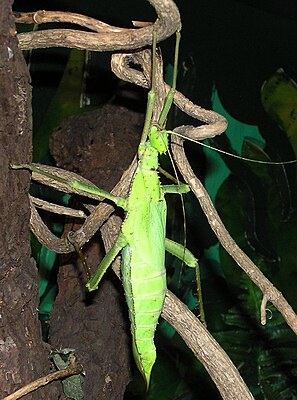Heteropterygini
| Heteropterygini | ||||||||||||
|---|---|---|---|---|---|---|---|---|---|---|---|---|

Malay giant ghost insect ( Heteropteryx dilatata ), ♀ |
||||||||||||
| Systematics | ||||||||||||
|
||||||||||||
| Scientific name of the subfamily | ||||||||||||
| Heteropteryginae | ||||||||||||
| Kirby , 1896 | ||||||||||||
| Scientific name of the tribe | ||||||||||||
| Heteropterygini | ||||||||||||
| Kirby , 1896 |
Heteropterygini is the only tribe within the subfamily of Heteropteryginae from the order of Gespenstschrecken (phasmatodea). With 18 representatives described, this subfamily represents both the poorest in species and that of the three subfamilies belonging to the Heteropterygidae family, to which the largest and most conspicuous species are counted.
features
The representatives of the Heteropterygini are almost always relatively large and heavy. The 14 to 17 centimeter long females of the Malay giant ghost insect ( Heteropteryx dilatata ) are likely to be among the heaviest phasmids at 30 to 70 grams.
A characteristic of this tribe are the wings that have been transformed into stridulation organs in females of all species . The short forewings ( tegmina ) cover the equally short hindwings and are primarily used to generate sounds (defensive stridulation). The wings of the males are also shortened in most species and converted into stridulation organs. The defensive stridulation is supplemented by the lifting of the abdomen and the clapping of the thorny hind legs. When tactile stimuli are perceived , the rails are knocked against the thighs like a folding knife , the aim of which is to pinch the opponent.
In adult females the abdomen is widened and significantly increased in the middle due to the eggs produced in large numbers. Your abdomen ends in a pointed spine that surrounds the actual ovipositor . This is formed ventrally from the eighth sternite , which is referred to here as the subgenital plate or operculum . Dorsally, the laying spine consists of the eleventh tergum, known as the supraanal plate or epiproct . The smaller males have a central abdomen with a rounded cross section, which, in contrast to the females, is thinnest here. The thickened end of the abdomen is formed ventrally by the subgenital plate and dorsally by the eighth, ninth and the tenth tergum, known as the anal segment.
The body can usually be covered with numerous pointed spines. The head, which is inclined downwards and forwards, has a species-specific number of thorns on the conical apex, which act like a crown.
Reproduction
The adult females lay their relatively large eggs individually using an ovipositor, several centimeters deep in the ground. In addition to species with an average life expectancy, there are many species that reach an age that is amazing for ghosts.
Systematics
In the subfamily Heteropteryginae there is a tribe , the Heteropterygini, whose 18 species have only been divided into two and no longer into three genera since this group was processed by Hennemann et al .
- ( Syn. = Heteropteryx Redtenbacher , 1906
- (Syn. = Miniopteryx Zompro , 2004)
- Haaniella aculeata Hennemann , Conle , Brock & Seow-Choen , 2016
- Haaniella dehaanii ( Westwood , 1859)
- Haaniella echinata ( Redtenbacher , 1906)
- Haaniella erringtoniae ( Redtenbacher , 1906)
- Haaniella gintingi Hennemann , Conle , Brock & Seow-Choen , 2016
- Haaniella glaber ( Redtenbacher , 1906)
- Haaniella gorochovi Hennemann , Conle , Brock & Seow-Choen , 2016
- Haaniella grayii ( Westwood , 1859)
- Haaniella jacobsoni Günther , 1944
- Haaniella kerincia Hennemann , Conle , Brock & Seow-Choen , 2016
- Haaniella macroptera Hennemann , Conle , Brock & Seow-Choen , 2016
- Haaniella mecheli ( Redtenbacher , 1906)
- Haaniella muelleri ( de Haan , 1842)
- Haaniella parva Günther , 1944
- Haaniella rosenbergii Kaup , 1871)
- Haaniella saussurei Kirby , 1904
- Haaniella scabra ( Redtenbacher , 1906)
- Heteropteryx Gray, GR , 1835
- (Syn. = Leocrates Stål , 1875)
- Heteropteryx dilatata ( Parkinson , 1798)
swell
- ^ A b Frank H. Hennemann , Oskar V. Conle , Paul D. Brock & Francis Seow-Choen : Zootaxa 4159 (1): Revision of the Oriental subfamiliy Heteropteryginae Kirby, 1896, with a re-arrangement of the family Heteropterygidae and the descriptions of five new species of Haaniella Kirby, 1904. (Phasmatodea: Areolatae: Heteropterygidae) , Magnolia Press, Auckland, New Zealand 2016, ISSN 1175-5326
- ↑ Oliver Zompro : Dwarf forms of Phasmatodea - the smallest among the giants , Arthropoda 16 (3) November 2008, Sungaya-Verlag Kiel. ISSN 0943-7274
- ↑ Oliver Zompro: Poles, ghosts, walking leaves - phasmid systematics at a glance I. , Arthropoda 17 (1) April 2009, Sungaya-Verlag Kiel. ISSN 0943-7274
- ↑ Ingo Fritzsche : Poles - Carausius, Sipyloidea & Co. , Natur und Tier Verlag, Münster 2007, ISBN 978-3-937285-84-9
- ↑ Christoph Seiler, Sven Bradler, Rainer Koch: Phasmids - care and breeding of ghost horrors, stick insects and walking leaves in the terrarium . bede, Ruhmannsfelden 2000, ISBN 3-933646-89-8
- ^ Paul D. Brock : Phasmida Species File Online . Version 5.0 / 5.0 (accessed September 11, 2016)
- ^ Roy Bäthe, Anke Bäthe & Mario Fuß: Phasmiden , Schüling Verlag, Münster 2009, pp. 134-137, ISBN 978-3-86523-073-7
